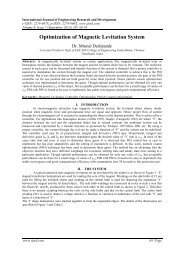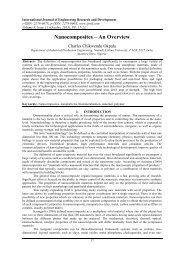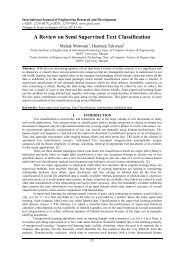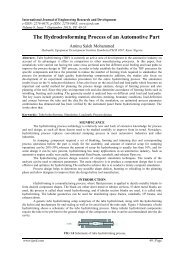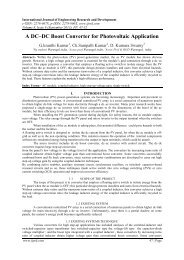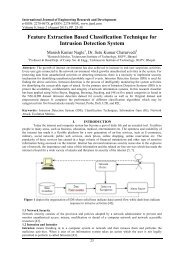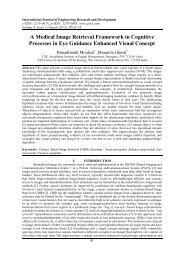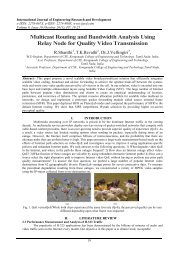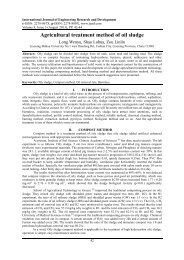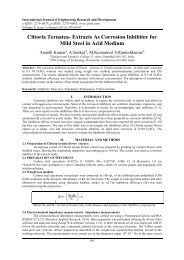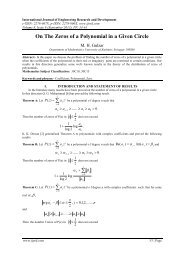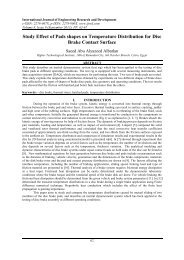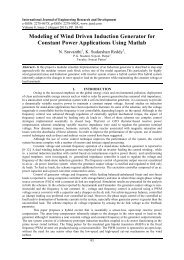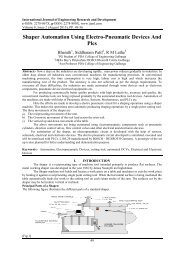Physical and Chemical Treatment of Sugarcane Waste for Use in Animal Diet
Create successful ePaper yourself
Turn your PDF publications into a flip-book with our unique Google optimized e-Paper software.
International Journal <strong>of</strong> Eng<strong>in</strong>eer<strong>in</strong>g Research <strong>and</strong> Development<br />
e-ISSN: 2278-067X, p-ISSN: 2278-800X, www.ijerd.com<br />
Volume 8, Issue 8 (September 2013), PP. 66-76<br />
<strong>Physical</strong> <strong>and</strong> <strong>Chemical</strong> <strong>Treatment</strong> <strong>of</strong> <strong>Sugarcane</strong> <strong>Waste</strong> <strong>for</strong><br />
<strong>Use</strong> <strong>in</strong> <strong>Animal</strong> <strong>Diet</strong><br />
Ana Carol<strong>in</strong>a de Souza 1 , Olivio Fern<strong>and</strong>es Galão 2 , Daniele Crist<strong>in</strong>a dos Santos<br />
B<strong>of</strong>o 3<br />
1,2 Department <strong>of</strong> Chemistry, University Center Votuporanga, Votuporanga 15500-006 - SP, Brazil<br />
3 Department <strong>of</strong> Chemistry, Londr<strong>in</strong>a Estate University.<br />
Abstract:- It is known that the waste sugarcane is one <strong>of</strong> most significant solid waste generated by sugarcane<br />
agribus<strong>in</strong>ess, due to the quantity generated. In order to identify which treatments <strong>of</strong> waste, <strong>for</strong> use <strong>in</strong> animal<br />
diets, exist<strong>in</strong>g was per<strong>for</strong>med a bibliographic review <strong>of</strong> scientific papers. Relevant <strong>in</strong><strong>for</strong>mation has been brought<br />
<strong>in</strong>to the possibility <strong>of</strong> reduc<strong>in</strong>g costs <strong>for</strong> sugarcane mills <strong>and</strong> consequently reduc<strong>in</strong>g the environmental impact<br />
with the process<strong>in</strong>g <strong>of</strong> waste <strong>in</strong> a byproduct. It can be noticed there is great potential <strong>of</strong> works <strong>and</strong> research<br />
focused on the sugarcane waste.<br />
Keywords:- <strong>Waste</strong>. <strong>Sugarcane</strong>. Lign<strong>in</strong>. Cellulose.<br />
I. INTRODUCTION<br />
Brazil has excellent conditions <strong>for</strong> the exploitation <strong>of</strong> cattle, goats <strong>and</strong> sheep graz<strong>in</strong>g, however, <strong>in</strong><br />
certa<strong>in</strong> regions, the difficulty <strong>of</strong> produc<strong>in</strong>g <strong>for</strong>age <strong>in</strong> the dry season, has been the ma<strong>in</strong> limitation to many<br />
producers (SARMENTO et al., 1999). In the tropical regions <strong>of</strong> Brazil, the seasonal <strong>for</strong>age production is a<br />
concrete fact which has caused huge losses to the national livestock because most producers are not prepared to<br />
supplement herd <strong>in</strong> the period <strong>of</strong> scarcity <strong>of</strong> good quality <strong>for</strong>age. Among the options available at the time, the<br />
use <strong>of</strong> crop residues <strong>and</strong> agro-<strong>in</strong>dustrial by-products have been shown to be <strong>in</strong>terest<strong>in</strong>g <strong>and</strong> feasible (CANDIDO<br />
et al., 1999).<br />
The waste sugarcane has been used as an alternative source to supplement animal <strong>for</strong> lack <strong>of</strong> fodder.<br />
However, s<strong>in</strong>ce, like other fibrous foods is composed <strong>of</strong> cellulose, hemicellulose <strong>and</strong> lign<strong>in</strong>, its use has been<br />
m<strong>in</strong>imized, because it is considered bulky low-grade (PIRES et al., 2006a). In Brazil, traditionally feedlot diets<br />
are balanced with high proportions <strong>of</strong> bulky due to the high costs <strong>of</strong> gra<strong>in</strong> <strong>and</strong> prote<strong>in</strong> concentrates (BULLE et<br />
al., 1999). The nutritional value <strong>of</strong> this lignocellulosic waste is low because the connections which occur<br />
between the cell wall cellulose, hemicellulose <strong>and</strong> lign<strong>in</strong>. However, there are some practical ways to improve<br />
the utilization <strong>of</strong> waste <strong>for</strong> animal feed. For this, they use chemical <strong>and</strong> physical treatments (TEIXEIRA et al.,<br />
2007).<br />
The chemical compound must possess certa<strong>in</strong> characteristics that their use can be recommended on a<br />
large scale: should promote effective <strong>in</strong>crease <strong>in</strong> digestibility <strong>and</strong> / or material consumption, the cost <strong>of</strong><br />
treatment should be feasible, the chemical must be highly available <strong>in</strong> the market, the chemical residue <strong>in</strong> the<br />
treated material may not be toxic to the animal, the chemical compound should be required nutrient by the<br />
animal or have fertilizer value, the chemical agent must have preservative action <strong>in</strong> case <strong>of</strong> preservation <strong>of</strong> the<br />
treated material; should not be toxic nor corrosive to man, <strong>and</strong> it is desirable that the chemical reaction is fast<br />
(SARMENTO et al., 1999).<br />
The physical <strong>and</strong> chemical treatments used to improve the quality <strong>of</strong> waste cane sugar, are designed to<br />
elim<strong>in</strong>ate or reduce the damag<strong>in</strong>g effects <strong>of</strong> lign<strong>in</strong> on degradation <strong>of</strong> cellulosic compounds by microorganisms<br />
<strong>in</strong> the rumen, promot<strong>in</strong>g the breakdown <strong>of</strong> complex chemical bonds that component with cellulose <strong>and</strong><br />
hemicellulose, provid<strong>in</strong>g the material theoretically <strong>for</strong> membership <strong>of</strong> the microbial population <strong>and</strong> enzymatic<br />
attack fibrolytic (VAN SOEST, 1994).<br />
Among the physical treatments, st<strong>and</strong> out gr<strong>in</strong>d<strong>in</strong>g <strong>and</strong> heat treatment, <strong>and</strong> among the chemicals, urea,<br />
anhydrous ammonia <strong>and</strong> sodium hydroxide, alkal<strong>in</strong>e products that normally promote reduction <strong>of</strong> neutral<br />
detergent fiber (NDF), which may positively <strong>in</strong>fluence the consumption <strong>of</strong> dry matter (DM) <strong>of</strong> food (PIRES et<br />
al, 2006a).<br />
However, the use <strong>of</strong> sodium hydroxide is decreas<strong>in</strong>g by negatively <strong>in</strong>fluence m<strong>in</strong>eral balance, <strong>in</strong>crease<br />
the pass<strong>in</strong>g rate <strong>of</strong> the cell wall <strong>in</strong> the rumen <strong>and</strong> decrease the activity <strong>of</strong> cellulolytic bacteria, provid<strong>in</strong>g<br />
decrease <strong>in</strong> potentially digestible fiber digestion <strong>in</strong> the rumen (SARMENTO, 1999). Accord<strong>in</strong>g to Teixeira<br />
(1990) cited by Sarmento (1999), the use <strong>of</strong> sodium hydroxide also causes an <strong>in</strong>crease <strong>in</strong> water <strong>in</strong>take <strong>and</strong>,<br />
www.ijerd.com 66 | Page
<strong>Physical</strong> <strong>and</strong> <strong>Chemical</strong> <strong>Treatment</strong> <strong>of</strong> <strong>Sugarcane</strong>…<br />
consequently, <strong>in</strong>creased ur<strong>in</strong>ary excretion, thus elim<strong>in</strong>at<strong>in</strong>g the excess <strong>of</strong> sodium <strong>in</strong>gested, which can result <strong>in</strong><br />
the accumulation <strong>of</strong> sodium <strong>in</strong> the soil.<br />
Anhydrous ammonia has a high nitrogen content (82%) <strong>and</strong> is typically obta<strong>in</strong>ed <strong>in</strong> the liquid state at<br />
high temperatures <strong>and</strong> pressures. The urea (NH2CONH2), which <strong>in</strong> turn has, on average, 44% nitrogen, is found<br />
<strong>in</strong> solid <strong>for</strong>m <strong>and</strong> requires the presence <strong>of</strong> moisture <strong>and</strong> the enzyme urease <strong>in</strong> order to produce CO2 <strong>and</strong> two<br />
NH 3, <strong>for</strong> each molecule <strong>of</strong> urea (PIRES et al., 2004).<br />
One effect <strong>of</strong> the action <strong>of</strong> ammonia on the unstructured material is the complex <strong>for</strong>med by fiber<br />
components (cellulose, hemicellulose <strong>and</strong> lign<strong>in</strong>) provid<strong>in</strong>g microorganisms largest area <strong>of</strong> exposure <strong>and</strong><br />
thereby <strong>in</strong>creas<strong>in</strong>g the degree <strong>of</strong> utilization <strong>of</strong> the different fractions <strong>of</strong> the fiber (GARCIA & NEIVA, 1994).<br />
Another effect is to <strong>in</strong>crease the nitrogen content <strong>and</strong> thus <strong>in</strong>creases availability <strong>for</strong> rumen microorganisms<br />
(Souza et al. 2001). Rosa (2000) reported that, as the material to be ammoniated usually has a low nitrogen<br />
content, which limits the development <strong>of</strong> microorganisms, the <strong>in</strong>crease <strong>in</strong> the content <strong>of</strong> this element after<br />
ammoniation, allows more efficient action <strong>of</strong> the rum<strong>in</strong>al bacteria on substrate, due to the <strong>in</strong>crease <strong>in</strong> crude<br />
prote<strong>in</strong> synthesized from the addition <strong>of</strong> non-prote<strong>in</strong> N. The use <strong>of</strong> urea as a source <strong>of</strong> ammonia has been<br />
studied because <strong>of</strong> its low cost <strong>and</strong> easy h<strong>and</strong>l<strong>in</strong>g (CANDIDO et al, 1999).<br />
It is proposed by this review, a survey <strong>of</strong> various <strong>for</strong>ms <strong>of</strong> treatment <strong>of</strong> the crushed cane sugar, among other<br />
biomass <strong>for</strong> use <strong>in</strong> animal diets that have been reported <strong>in</strong> the literature.<br />
II. BIOMASS TREATED WITH UREA<br />
Carvalho (2006) used four doses <strong>of</strong> urea, 0, 2.5, 5.0 <strong>and</strong> 7.5%, <strong>for</strong> the treatment <strong>of</strong> waste sugarcane.<br />
There was a l<strong>in</strong>ear <strong>in</strong>crease <strong>in</strong> crude prote<strong>in</strong> (CP), with the <strong>in</strong>clusion <strong>of</strong> urea doses to waste. The m<strong>in</strong>imum level<br />
<strong>of</strong> PB to promote the proper function<strong>in</strong>g <strong>of</strong> the rumen (7.0% CP) was obta<strong>in</strong>ed with the addition <strong>of</strong> 2.62% urea<br />
to the value calculated from the l<strong>in</strong>ear regression equation. For the levels <strong>of</strong> neutral detergent fiber (NDF) <strong>of</strong><br />
waste, there was a l<strong>in</strong>ear decrease with <strong>in</strong>creas<strong>in</strong>g doses <strong>of</strong> urea. NDF found <strong>in</strong> MS waste were 78.1, 71.3, 64.4<br />
<strong>and</strong> 57.6%, <strong>for</strong> the respective doses <strong>of</strong> 0, 2.5, 5.0 <strong>and</strong> 7.5% <strong>of</strong> the additive.<br />
Also accord<strong>in</strong>g to the Carvalho work (2006), ammoniation decreased waste hemicellulose, at<br />
<strong>in</strong>creas<strong>in</strong>g doses <strong>of</strong> urea. The amounts <strong>of</strong> acid detergent fiber (ADF) were checked 49.0, 44.4, 39.6 <strong>and</strong> 34.9%,<br />
respectively, <strong>for</strong> the urea doses 0, 2.5, 5.0 <strong>and</strong> 7.5%. With the <strong>in</strong>crease <strong>of</strong> urea, the content <strong>of</strong> cellulose <strong>and</strong><br />
lign<strong>in</strong> decreased. This was possibly by dissolv<strong>in</strong>g part <strong>of</strong> lign<strong>in</strong> <strong>and</strong> the disruption <strong>of</strong> the <strong>in</strong>termolecular ester<br />
bonds between uronic acid hemicellulose <strong>and</strong> cellulose, dur<strong>in</strong>g ammoniation (VAN SOEST, 1994). Significant<br />
mean <strong>in</strong>creases were observed <strong>in</strong> vitro digestibility (IVDMD) <strong>of</strong> treated waste 13.78, 24.20 <strong>and</strong> 32.42%,<br />
respectively, with the application <strong>of</strong> 2.5, 5.0 <strong>and</strong> 7.5% urea <strong>in</strong> compared to untreated waste. Accord<strong>in</strong>g to the<br />
authors the <strong>in</strong>crease <strong>in</strong> IVDMD <strong>of</strong> <strong>for</strong>age treated with alkali, usually <strong>in</strong>crease the <strong>in</strong>take <strong>and</strong> per<strong>for</strong>mance, <strong>and</strong><br />
can sometimes provide similar results <strong>in</strong> terms <strong>of</strong> per<strong>for</strong>mance when compared to diets <strong>of</strong> higher quality.<br />
Sarmento (1999) also used to treat urea waste from cane sugar. The results <strong>of</strong> CP, NDF, hemicellulose <strong>and</strong><br />
IVDMD were consistent with the results obta<strong>in</strong>ed by Carvalho (2006). The treatments FDA, no significant<br />
effect was observed <strong>for</strong> the levels <strong>of</strong> urea applied. No change <strong>of</strong> cell wall components such as cellulose <strong>and</strong><br />
lign<strong>in</strong>.<br />
Carvalho (2007) added three doses <strong>of</strong> urea (2.5%, 5.0% <strong>and</strong> 7.5% based on the dry matter - DM) to<br />
waste cane sugar, which promoted <strong>in</strong>creased IVDMD , PB <strong>and</strong> also the degradation <strong>of</strong> cell wall constituents.<br />
C<strong>and</strong>ido (1999) studied doses <strong>of</strong> 2, 4, 6 <strong>and</strong> 8% urea on a dry matter basis. The parameters analyzed were CP,<br />
NDF <strong>and</strong> IVDMD, <strong>and</strong> the results obta<strong>in</strong>ed are <strong>in</strong> agreement with Carvalho (2006) <strong>and</strong> Sarmento (1999).<br />
Pires (2006), subjected Brachiaria brizantha to different doses (under dry hay) urea at different levels <strong>of</strong><br />
humidity. Urea was used <strong>in</strong> the ratios <strong>of</strong> 3:05 p.100 dry weight <strong>of</strong> cells bales. Were verified <strong>in</strong>crease <strong>in</strong> crude<br />
prote<strong>in</strong> content <strong>of</strong> the hay. For variables NDF, ADF, lign<strong>in</strong> <strong>and</strong> cellulose found to decrease between the treated<br />
<strong>and</strong> untreated hay. For hemicellulose significant difference was not detected. Values <strong>of</strong> 34.3 <strong>and</strong> 43.5 <strong>for</strong><br />
IVDMD were found <strong>in</strong> the treatment <strong>and</strong> control 5 p.100 urea with 30 p. 100 moisture conclud<strong>in</strong>g improv<strong>in</strong>g the<br />
nutritional value <strong>of</strong> Brachiaria brizantha after treatment with urea.<br />
III. BIOMASS TREATED WITH AMMONIA<br />
Pires (2004) treated waste from sugarcane with 4% anhydrous ammonia based on dry matter. For the<br />
b<strong>in</strong> received no treatment, the material appeared almost entirely lost, mak<strong>in</strong>g it necessary, after 10 months,<br />
which is the beg<strong>in</strong>n<strong>in</strong>g <strong>of</strong> the experiment, sugarcane waste acquire aga<strong>in</strong> to correspond to the control treatment.<br />
The waste silos that received treatment with anhydrous ammonia showed no visible signs <strong>of</strong> fungus. For silos<br />
that received treatment with NH3, observed <strong>in</strong>creased CP <strong>and</strong> IVDMD, reduc<strong>in</strong>g NDF <strong>and</strong> hemicellulose <strong>and</strong><br />
m<strong>in</strong>or variations <strong>in</strong> the values <strong>of</strong> ADF <strong>and</strong> cellulose. Based on these results, we can verify the efficiency <strong>of</strong> NH3<br />
(dose <strong>of</strong> 4% DM basis) <strong>in</strong> the treatment <strong>of</strong> waste cane sugar.<br />
Gesualdi, (2001) used anhydrous ammonia (1, 2 <strong>and</strong> 4%) to treat waste from sugarcane. A decrease <strong>in</strong><br />
NDF, cellulose <strong>and</strong> hemicellulose both, depend<strong>in</strong>g on the treatment with ammonia. The ADF content <strong>in</strong>creased<br />
www.ijerd.com 67 | Page
<strong>Physical</strong> <strong>and</strong> <strong>Chemical</strong> <strong>Treatment</strong> <strong>of</strong> <strong>Sugarcane</strong>…<br />
with the treatment <strong>of</strong> pulp <strong>and</strong> rema<strong>in</strong>ed virtually unchanged <strong>for</strong> the treatment <strong>of</strong> the tip <strong>of</strong> cane sugar. Pires<br />
(2006b), treated Brachiaria brizantha with anhydrous ammonia that was <strong>in</strong>jected <strong>in</strong>to the bales conta<strong>in</strong>ed <strong>in</strong><br />
each cell, the amount <strong>of</strong> 3 dry weight. There was considerable <strong>in</strong>crease <strong>in</strong> crude prote<strong>in</strong> content <strong>and</strong> IVDMD <strong>of</strong><br />
hay. For variables NDF, ADF, hemicellulose, lign<strong>in</strong> <strong>and</strong> cellulose was found less variation between the treated<br />
<strong>and</strong> untreated hay.<br />
Rose (1998) evaluated the effects <strong>of</strong> ammoniated hay Brachiaria decumbens add<strong>in</strong>g 2 <strong>and</strong> 3%<br />
anhydrous ammonia based on dry matter. Reduction was observed <strong>in</strong> the contents <strong>of</strong> NDF <strong>and</strong> hemicellulose,<br />
due to ammoniation. The treatment did not cause significant changes <strong>in</strong> the contents <strong>of</strong> ADF, lign<strong>in</strong> <strong>and</strong><br />
cellulose. Ammoniation <strong>in</strong>creased the <strong>in</strong> vitro digestibility <strong>of</strong> dry matter.<br />
Treated biomass with calcium oxide<br />
Geron (2010), used the quicklime calcium oxide at a dosage <strong>of</strong> 0.5% <strong>for</strong> each 100 kg <strong>of</strong> waste from<br />
sugarcane <strong>in</strong> natura (BIN) diluted <strong>in</strong> four liters <strong>of</strong> water to provide the <strong>for</strong>mation <strong>of</strong> calcium hydroxide.<br />
The dry matter (DM), organic matter (OM), NDF, ADF <strong>and</strong> m<strong>in</strong>eral matter (MM) showed no changes between<br />
the BIN <strong>and</strong> waste-sugar hydrolyzate (BHI) kept <strong>for</strong> 28 days. The authors concluded, then, that the process<strong>in</strong>g<br />
<strong>of</strong> sugarcane waste-sugar fresh with lime (CaO) <strong>for</strong> mak<strong>in</strong>g pulp from sugarcane hydrolyzate does not change<br />
the contents <strong>of</strong> dry matter, organic matter, neutral detergent fiber <strong>and</strong> acid detergent fiber <strong>and</strong> m<strong>in</strong>eral matter <strong>in</strong><br />
relation to the orig<strong>in</strong>al raw material (waste sugarcane <strong>in</strong> natura) dur<strong>in</strong>g the retention period <strong>of</strong> 28 days. So the<br />
crushed sugarcane can be kept fresh <strong>for</strong> 28 days without the use <strong>of</strong> lime. Carvalho (2009), also tested<br />
calcium oxide to treat waste from sugarcane. The experiment was conducted with four doses <strong>of</strong> calcium oxide,<br />
0, 1.25, 2.5 or 3.75%, based on dry matter. The crude prote<strong>in</strong> <strong>and</strong> lign<strong>in</strong> from sugarcane waste were not affected<br />
by the addition <strong>of</strong> calcium oxide. As <strong>for</strong> NDF, ADF <strong>and</strong> cellulose contents decreased l<strong>in</strong>early as <strong>in</strong>creased doses<br />
<strong>of</strong> calcium oxide <strong>in</strong> waste cane sugar. Murta (2009) hydrolyzed waste from sugarcane with doses <strong>of</strong> 0.75,<br />
1.5 <strong>and</strong> 2.25% CaO. The percentage <strong>of</strong> dry matter <strong>and</strong> crude prote<strong>in</strong> rema<strong>in</strong>ed virtually unchanged <strong>and</strong> the NDF,<br />
ADF, lign<strong>in</strong> <strong>and</strong> cellulose decreased with the addition <strong>of</strong> sodium oxide, the latter two be<strong>in</strong>g less significant.<br />
Accord<strong>in</strong>g Balieiro Neto (2007) the use <strong>of</strong> CaO as an additive promoted reduction <strong>in</strong> fiber content <strong>and</strong><br />
<strong>in</strong>creased digestibility. Accord<strong>in</strong>g to the authors the additive level <strong>of</strong> 1% was able to <strong>in</strong>crease digestibility,<br />
reduce cell wall constituents, ma<strong>in</strong>ta<strong>in</strong><strong>in</strong>g NDF <strong>and</strong> hemicellulose after open<strong>in</strong>g the silo <strong>and</strong> promote greater<br />
stability <strong>of</strong> the chemical composition <strong>and</strong> better silage quality.<br />
Ribeiro (2009), studied three doses <strong>of</strong> CaO (0.75, 1.5 <strong>and</strong> 2.25%) based on natural raw cane sugar. The<br />
doses <strong>of</strong> calcium oxide caused a l<strong>in</strong>ear <strong>in</strong>crease <strong>in</strong> dry matter digestibility <strong>of</strong> cane sugar <strong>and</strong> decrease <strong>of</strong> NDF,<br />
ADF, hemicellulose, cellulose <strong>and</strong> lign<strong>in</strong>.<br />
Treated biomass with sodium hydroxide<br />
Sarmento (1999) cited by Pires (2006a) have reported that <strong>in</strong>creas<strong>in</strong>g IVDMD material is treated with<br />
alkal<strong>in</strong>e result <strong>of</strong> the partial solubilization <strong>of</strong> hemicellulose <strong>and</strong> cellulose <strong>of</strong> the expansion, which facilitates the<br />
attack the cell wall <strong>of</strong> microorganisms such material. Hydrolytic alkal<strong>in</strong>e reagents such as sodium hydroxide<br />
cause partial solubilization <strong>of</strong> hemicellulose <strong>and</strong> lign<strong>in</strong>, by act<strong>in</strong>g on the l<strong>in</strong>ks that connect them, <strong>and</strong> covalent<br />
ester type, which are found <strong>in</strong> grasses (VAN SOEST, 1994).<br />
Pires (2006a) used three doses (2.5, 5 <strong>and</strong> 7.5% DM basis) <strong>of</strong> a solution 2:1 (w:w) water: sodium<br />
hydroxide <strong>for</strong> treatment periods <strong>of</strong> 1, 3, 5 <strong>and</strong> 7 days. At work there was no effect <strong>of</strong> the <strong>in</strong>teraction doses <strong>of</strong><br />
NaOH × days <strong>of</strong> treatment <strong>for</strong> any <strong>of</strong> the variables studied. No effect was observed <strong>for</strong> MS accord<strong>in</strong>g doses <strong>of</strong><br />
NaOH. No effect <strong>of</strong> NaOH <strong>and</strong> doses <strong>of</strong> treatment days on the CP content, calculated by total nitrogen (TN).<br />
However, there was a significant effect <strong>of</strong> doses <strong>of</strong> NaOH, while a reduction <strong>in</strong> NDF, ADF, cellulose, lign<strong>in</strong> <strong>and</strong><br />
hemicellulose. Also was no effect <strong>of</strong> <strong>in</strong>creas<strong>in</strong>g doses <strong>of</strong> NaOH on IVDMD. Manzano (2000) treated waste from<br />
sugarcane with 9% H 2O 2 <strong>and</strong> 7% NaOH based on dry matter. The treatment <strong>of</strong> sugarcane waste <strong>in</strong>creased the <strong>in</strong><br />
vitro digestibility <strong>of</strong> DM <strong>and</strong> OM. The NDF content decreased with treatment. This observed variation <strong>in</strong> the<br />
fraction <strong>of</strong> NDF was due to variation detected <strong>for</strong> the concentration <strong>of</strong> hemicellulose, which was significantly<br />
lower <strong>for</strong> the waste. The ADF fraction showed no significant differences between the treated <strong>and</strong> waste <strong>in</strong><br />
natura. The waste showed lower values <strong>of</strong> lign<strong>in</strong> relative to that shown by BIN.<br />
Ribeiro (2009) dealt with the cane sugar with three doses <strong>of</strong> NaOH (0.75, 1.5 <strong>and</strong> 2.25%) based on natural<br />
matter. The additive <strong>in</strong>fluenced the lign<strong>in</strong>, which quadractricaly, with a m<strong>in</strong>imum <strong>of</strong> 0.13% at 1.63% NaOH,<br />
while <strong>in</strong> cane sugar without additive, rema<strong>in</strong>ed constant (7.1%). Doses <strong>of</strong> sodium hydroxide caused a l<strong>in</strong>ear<br />
<strong>in</strong>crease <strong>in</strong> dry matter digestibility <strong>of</strong> cane sugar <strong>and</strong> decrease <strong>of</strong> NDF, ADF, hemicellulose <strong>and</strong> cellulose.<br />
IV. BIOMASS STEAM PRESSURE TREATED<br />
In the physical process when submitt<strong>in</strong>g the crushed sugarcane vapor pressure occur by the action <strong>of</strong><br />
water, the swell<strong>in</strong>g <strong>of</strong> the cell wall matrix. After sudden decompression <strong>of</strong> the mass <strong>of</strong> the steam condensate<br />
www.ijerd.com 68 | Page
<strong>Physical</strong> <strong>and</strong> <strong>Chemical</strong> <strong>Treatment</strong> <strong>of</strong> <strong>Sugarcane</strong>…<br />
evaporate with<strong>in</strong> the fiber, which cause expansion there<strong>of</strong>. The fibers treated <strong>in</strong> this way are much more porous<br />
<strong>and</strong> susceptible to degradation <strong>in</strong> the rumen (GUTMANIS, 1987).<br />
Mello Junior (1989) treated waste from sugarcane at a pressure <strong>of</strong> 17 kg / cm² <strong>for</strong> 5 m<strong>in</strong>utes at<br />
temperature rang<strong>in</strong>g between 200 <strong>and</strong> 220°C. The prote<strong>in</strong> rema<strong>in</strong>ed virtually unchanged <strong>and</strong> no differences were<br />
observed between the cellulose sugarcane waste (BIN) <strong>and</strong> waste (BT). There was a more marked effect <strong>of</strong><br />
treatment on the content <strong>of</strong> hemicellulose with a fall <strong>of</strong> 31.43% to 06.27% <strong>of</strong> the BIN BT. Accord<strong>in</strong>g to the<br />
authors this fact is probably due to the separation <strong>of</strong> hemicellulose from the lign<strong>in</strong> cha<strong>in</strong>s caus<strong>in</strong>g that structural<br />
carbohydrate hydrolysis <strong>and</strong> subsequent <strong>in</strong>crease <strong>in</strong> soluble carbohydrates. With the reduction <strong>in</strong> the content <strong>of</strong><br />
hemicellulose is a proportional reduction <strong>in</strong> NDF content <strong>of</strong> 94.82% to 64.92%.<br />
Manzano (2000) conducted treatment with steam under pressure (17 kg/cm2 <strong>for</strong> 5 m<strong>in</strong>) <strong>for</strong> waste from<br />
cane sugar. There was a small <strong>in</strong>crease <strong>in</strong> the values <strong>of</strong> <strong>in</strong> vitro dry matter digestibility (IVDMD) <strong>and</strong> <strong>in</strong> vitro<br />
digestibility <strong>of</strong> organic matter (IVOMD) <strong>of</strong> BT <strong>in</strong> relation to the BIN. The CP <strong>and</strong> cellulose rema<strong>in</strong>ed<br />
unchanged. Observed lower values <strong>for</strong> the ADF <strong>and</strong> lign<strong>in</strong> displayed by BIN. The largest variations were<br />
observed <strong>for</strong> hemicellulose <strong>and</strong> NDF.<br />
V. BIOMASS TREATED WITH SULPHUR COMPOUNDS<br />
Manzano (2000) treated waste with sulfur compounds, which are (<strong>in</strong> parentheses concentrations <strong>of</strong><br />
chemical reagents DM basis sugarcane waste):<br />
1 - <strong>Waste</strong> <strong>in</strong> natura - BIN<br />
2 - 0,66% Na2SO3 (5% Na2SO3) solution<br />
3 - 0,53% Na2S + 0,8% NaOH (4% Na2S + 6% NaOH) solution<br />
4 - 0,4% Na2S + 0,6% NaOH (3% Na2S + 4,5% NaOH) solution<br />
5 - 0,27% Na2S + 0,4% NaOH (2% Na2S + 3% NaOH) solution<br />
6 - 0,4% Na2S + 0,6% NH4OH (3% Na2S + 4,5% NH4OH) solution<br />
7 - 0,66% Na2SO3 + 0,33% NH4OH (5% Na2SO3 + 2,5% NH4OH) solution<br />
8 - 0,66% NaHSO3 + 0,33% NH4OH (5% NaHSO3 + 2,5% NH4OH) solution<br />
The values <strong>of</strong> IVDMD <strong>and</strong> IVOMD pomace treated were higher than the average <strong>of</strong> BIN. It is a<br />
highlight <strong>for</strong> the treatment <strong>of</strong> waste 3 (4.0% + 6.0% NaOH Na 2S) that the OMIVD <strong>in</strong>creased by 129% compared<br />
with the BIN. The crude prote<strong>in</strong>, cellulose <strong>and</strong> FDA showed no statistical differences. The largest variation<br />
observed NDF, hemicellulose <strong>and</strong> lign<strong>in</strong> were on treatment with 4% 6% NaOH + Na2S.<br />
Pires (2004) used 2.5% Na2S <strong>and</strong> 2.5% Na2S + 4% NH3 to treat waste. There was a large loss <strong>of</strong><br />
material treated only with sulfide. However, the mold material had been removed, provid<strong>in</strong>g only that they are<br />
no signs <strong>of</strong> visible fungi. For the silo that received no treatment, the material appeared almost entirely lost. The<br />
waste silos that received treatment with anhydrous ammonia showed no visible signs <strong>of</strong> fungus. It is found that<br />
the addition <strong>of</strong> Na2S did not change the composition or IVDMD. However, <strong>for</strong> the treatments <strong>in</strong> which we used<br />
NH3, reveals <strong>in</strong>creased CP <strong>and</strong> IVDMD, reduc<strong>in</strong>g NDF <strong>and</strong> hemicellulose <strong>and</strong> m<strong>in</strong>or variations <strong>in</strong> the values <strong>of</strong><br />
ADF <strong>and</strong> cellulose. Gesualdi (2001) used ammonium sulfate (1, 2 <strong>and</strong> 4%) to treat waste from cane sugar. There<br />
was a decrease <strong>in</strong> NDF, ADF <strong>and</strong> hemicellulose waste as a function <strong>of</strong> treatment with sodium sulfide.<br />
The work <strong>of</strong> Pires (2003) was the sorghum silage which was treated with 2.5% sodium sulfide. The authors<br />
observed the presence <strong>of</strong> fungi <strong>in</strong> some parts <strong>of</strong> the silo after its open<strong>in</strong>g. The sodium sulfide caused no changes<br />
<strong>in</strong> the parameters studied.<br />
VI. COMPARISON BETWEEN TREATMENTS<br />
Analyz<strong>in</strong>g the data items set <strong>for</strong>th above, were mounted graphics to compare the efficiency <strong>of</strong> each<br />
treatment on biomass <strong>for</strong> use <strong>in</strong> animal diets. The articles have shown diverse results accord<strong>in</strong>g to the treatment<br />
period or the content <strong>of</strong> additives used. There<strong>for</strong>e, <strong>for</strong> assembl<strong>in</strong>g the graphs, the results were chosen higher<br />
efficiency <strong>of</strong> treatment.<br />
Percentage reduction <strong>of</strong> neutral detergent fiber (NDF)<br />
The graph <strong>of</strong> Figure 1 shows the percentage reduction <strong>of</strong> NDF after treatment, the biomass treated with<br />
various reagents. Most cited articles used as biomass waste from sugarcane, were also cited articles that used the<br />
Brachiaria brizantha <strong>and</strong> cane sugar. Pires et al. (2006b) treated the Brachiaria brizantha with ammonia;<br />
Ribeiro et al. (2009) treated sugarcane with sodium hydroxide <strong>and</strong> Balieiro Neto (2007) used calcium oxide <strong>for</strong><br />
treat<strong>in</strong>g sugarcane.<br />
www.ijerd.com 69 | Page
<strong>Physical</strong> <strong>and</strong> <strong>Chemical</strong> <strong>Treatment</strong> <strong>of</strong> <strong>Sugarcane</strong>…<br />
Figure 1. Comparison <strong>of</strong> percentage reduction <strong>of</strong> NDF among the articles analyzed<br />
Accord<strong>in</strong>g to the graph <strong>in</strong> Figure 1 the three best results <strong>for</strong> reduc<strong>in</strong>g NDF biomass was <strong>for</strong> treatments<br />
with sulfur compounds (31.59%) <strong>and</strong> vapor pressure (31.54 <strong>and</strong> 30.58%) held by Manzano (2000), <strong>and</strong> Mello<br />
Junior (1989) respectively.<br />
The difference between the results <strong>of</strong> the articles that used sulfur compounds is due to the fact Manzano<br />
(2000) have used the chemical sulphide <strong>in</strong> alkal<strong>in</strong>e solution (NaOH) with a vapor pressure <strong>of</strong> 12 kgf/cm2 <strong>for</strong> 8<br />
m<strong>in</strong>utes <strong>and</strong> Pires (2004) <strong>and</strong> Gesualdi (2001) only <strong>in</strong> aqueous solution. It is concluded that the use <strong>of</strong> sodium<br />
sulphide comb<strong>in</strong>ed with the compound <strong>in</strong>creases the efficiency <strong>of</strong> the treatment with respect to the parameter<br />
NDF when compared to isolated use <strong>of</strong> the sulfur compound.<br />
Sarmento (1999) used 10% urea based dry matter <strong>and</strong> stored <strong>in</strong> the silo ammoniated by gett<strong>in</strong>g 97 days,<br />
after this period, a decrease <strong>of</strong> 4.4% NDF. Carvalho (2006) <strong>and</strong> Carvalho (2007) added 7.5% urea <strong>and</strong> achieved<br />
a much higher percentage <strong>of</strong> reduction after 110 days, as shown <strong>in</strong> Figure 1.<br />
Pires (2004), treated waste from cane sugar with 4% ammonia <strong>for</strong> 10 months, reduc<strong>in</strong>g almost 5 times<br />
more NDF content compared with Gesualdi (2001) who used the same percentage <strong>of</strong> the additive <strong>and</strong> 30 days<br />
storage. Pires (2006b) reported no treatment period.<br />
Among the articles that treated biomass with calcium oxide, Balieiro Neto (2007) was the use <strong>of</strong> the additive the<br />
lowest percentage (2%) <strong>and</strong> achieved the highest percentage reduction <strong>of</strong> NDF 27.39% after 84 days <strong>of</strong> storage.<br />
Carvalho (2009) used 3.75% calcium oxide <strong>and</strong> up to 36 hours <strong>of</strong> storage, reach<strong>in</strong>g a reduction <strong>of</strong> 10,58% NDF.<br />
Murta (2009) added 2.25% calcium oxide <strong>and</strong> obta<strong>in</strong>ed 7.84% reduction was not mentioned <strong>in</strong> the article<br />
storage.<br />
Manzano (2000) 7% added sodium hydroxide mixed with 9% hydrogen peroxide waste <strong>in</strong> cane sugar<br />
<strong>and</strong> obta<strong>in</strong>ed a reduction percentage <strong>of</strong> NDF almost three times greater than Pires (2006a), which added 7.5 %<br />
sodium hydroxide solution. Ribeiro (2009) dealt with the cane sugar with 2.25% NaOH, based on natural matter<br />
<strong>and</strong> also managed to reduce the NDF almost three times more than Pires (2006a).<br />
Percent reduction <strong>of</strong> acid detergent fiber (ADF)<br />
Some articles cited <strong>in</strong> Figure 2 studies conducted with Brachiaria brizantha, the cane sugar <strong>and</strong> the tip<br />
<strong>of</strong> the cane sugar, although the authors <strong>of</strong> these articles Pires (2006b), Ribeiro (2009), <strong>and</strong> Gesualdi (2001).<br />
S<strong>in</strong>ce Gesualdi (2001) used the tip <strong>of</strong> the cane sugar to treatment with ammonia, already on treatment with<br />
sulfur compounds was used waste from cane sugar. Balieiro Neto (2007) also used the cane sugar <strong>in</strong> the studies.<br />
All other articles analyzed used only waste from cane sugar to the research.<br />
www.ijerd.com 70 | Page
<strong>Physical</strong> <strong>and</strong> <strong>Chemical</strong> <strong>Treatment</strong> <strong>of</strong> <strong>Sugarcane</strong>…<br />
Figure 2. Comparison <strong>of</strong> percentage reduction between the FDA analyzed articles<br />
Accord<strong>in</strong>g to the graph <strong>in</strong> Figure 2 the best results obta<strong>in</strong>ed <strong>for</strong> reduction <strong>of</strong> biomass was FDA <strong>for</strong> the<br />
treatment <strong>of</strong> waste cane sugar us<strong>in</strong>g urea as an additive, 28.83% <strong>and</strong> 26.89%, made by Oak (2006) <strong>and</strong> Carvalho<br />
(2007) respectively. Pires (2006b) added 3% urea <strong>in</strong> Brachiaria hay <strong>and</strong> got half the percentage reduction<br />
compared with FDA Carvalho (2006) <strong>and</strong> Carvalho (2007), which added 7.5% urea waste <strong>in</strong> cane sugar<br />
Pires (2004) treated waste from cane sugar with 4% ammonia <strong>for</strong> a period <strong>of</strong> 10 months, gett<strong>in</strong>g double<br />
reduction when compared to FDA Pires (2006b) us<strong>in</strong>g 3% ammonia to treat hay Brachiaria. Pires (2006b) did<br />
not mention <strong>in</strong> the article the treatment period waste. The percentage reduction FDA tip sugarcane, when<br />
Gesualdi (2001) treated with 4% ammonia <strong>for</strong> 30 days was not significant (0.04%).<br />
Manzano (2000) <strong>and</strong> Mello Junior (1989) treated waste from sugarcane with a vapor pressure under the<br />
same conditions (17 Kg/cm2 <strong>for</strong> 5m<strong>in</strong>) <strong>and</strong> obta<strong>in</strong>ed results similar reduction FDA, 4.78 <strong>and</strong> 7.42 %,<br />
respectively.<br />
Pires (2006a) treated waste from sugarcane with 7.5% sodium hydroxide <strong>and</strong> obta<strong>in</strong>ed a reduction <strong>of</strong><br />
7.51% <strong>of</strong> FDA. Ribeiro et al. (2009) added <strong>in</strong> 2.25% NaOH cane sugar <strong>and</strong> managed twice the reduction FDA,<br />
as shown <strong>in</strong> Figure 2. Manzano et al. (2000) did not achieve significant results <strong>for</strong> this parameter us<strong>in</strong>g sodium<br />
hydroxide<br />
The articles referred to the treatment <strong>of</strong> the crushed cane sugar with sulfur compounds had similar<br />
outcomes, to reduce FDA. Likewise, Balieiro Neto (2007) <strong>and</strong> Murta (2009) who treated biomass with calcium<br />
oxide reduction achieved similar results, 15.12 <strong>and</strong> 15.79% respectively. Carvalho (2009) used 3.75% <strong>of</strong> CaO<br />
<strong>and</strong> obta<strong>in</strong>ed a result somewhat smaller than the latter two authors (10.22%).<br />
Percent reduction <strong>of</strong> the hemicellulose<br />
The graph <strong>of</strong> Figure 3 shows the percentage reduction <strong>of</strong> hemicellulose, after treatment, the biomass<br />
treated with various reagents. Pires (2006b) used <strong>for</strong> the treatment Brachiaria brizantha, Ribeiro (2009) <strong>and</strong><br />
Balieiro Neto 2007) to cane sugar.<br />
Figura 1. Comparação da porcentagem de redução da hemicelulose entre os artigos analisados<br />
www.ijerd.com 71 | Page
<strong>Physical</strong> <strong>and</strong> <strong>Chemical</strong> <strong>Treatment</strong> <strong>of</strong> <strong>Sugarcane</strong>…<br />
The graph <strong>in</strong> Figure 3 shows that the best results obta<strong>in</strong>ed <strong>for</strong> reduction <strong>of</strong> biomass hemicellulose was<br />
<strong>for</strong> treatments <strong>of</strong> waste sugar-pressure steam (72.35 <strong>and</strong> 80.25%) <strong>and</strong> sulfur compounds (72.35 %) carried out<br />
by Manzano (2000), <strong>and</strong> Mello Jr. (1989). compounds used. And Manzano (2000) utilized a 4% Na 2 S diluted<br />
<strong>in</strong> a solution conta<strong>in</strong><strong>in</strong>g 6% NaOH <strong>and</strong> steam pressure <strong>of</strong> 12 kgf/cm2 <strong>for</strong> 8 m<strong>in</strong>utes. Pires (2004) <strong>and</strong> Gesualdi<br />
(2001) used the sulfur compound <strong>in</strong> aqueous solution. As the parameter <strong>for</strong> NDF, the use <strong>of</strong> sodium sulphide<br />
comb<strong>in</strong>ed with the compound <strong>in</strong>creases the efficiency <strong>of</strong> treatment <strong>for</strong> hemicellulose as compared to us<strong>in</strong>g the<br />
sulfur-conta<strong>in</strong><strong>in</strong>g compound alone.<br />
Manzano (2000) treated waste from cane sugar with 7% sodium hydroxide comb<strong>in</strong>ed with 9%<br />
hydrogen peroxide achiev<strong>in</strong>g a reduction <strong>of</strong> hemicellulose four times Pires et al. (2006a) us<strong>in</strong>g 7.5% sodium<br />
hydroxide <strong>in</strong> aqueous solution. Ribeiro (2009) treated sugarcane with 2.25% NaOH <strong>and</strong> succeeded <strong>in</strong> reduc<strong>in</strong>g<br />
the hemicellulose content <strong>of</strong> more than twice Pires e (2006a).<br />
For treatment with calcium oxide factor determ<strong>in</strong><strong>in</strong>g the difference between the papers was probably the<br />
treatment time. Balieiro Neto (2007) stored silage <strong>of</strong> cane sugar <strong>for</strong> 84 days. The reduction <strong>of</strong> 44.9% was<br />
achieved after n<strong>in</strong>e days <strong>of</strong> the silo open<strong>in</strong>g. The other two articles cited stored biomass treated <strong>for</strong> a maximum<br />
<strong>of</strong> 36 hours.<br />
The percentage reduction <strong>of</strong> the hemicellulose sugarcane tip when Gesualdi (2001) treated with 4%<br />
ammonia <strong>for</strong> 30 days was almost half that achieved by Pires (2004) who treated waste from cane sugar with 4%<br />
ammonia <strong>for</strong> a period <strong>of</strong> 10 months. Pires (2006b) used 3% ammonia to treat hay Brachiaria, not be<strong>in</strong>g<br />
mentioned <strong>in</strong> the article, the period <strong>of</strong> treatment. The percentage <strong>of</strong> reduction was 7.37%.<br />
Sarmento (1999), Carvalho (2006) <strong>and</strong> Carvalho (2007) treated waste from cane sugar with 10 <strong>and</strong> 7.5% urea<br />
<strong>and</strong> obta<strong>in</strong>ed results similar reduction <strong>of</strong> hemicellulose, 24.4, 21.8 <strong>and</strong> 2149% respectively.<br />
Percent reduction <strong>in</strong> lign<strong>in</strong><br />
The graph <strong>in</strong> Figure 4 shows the percentage <strong>of</strong> reduc<strong>in</strong>g lign<strong>in</strong> after treatment, the biomass treated with<br />
various reagents. Pires (2006b) used <strong>for</strong> the treatment Brachiaria Brizantha, Rose (1998) used the B. decumbens<br />
hay, Ribeiro (2009) <strong>and</strong> Balieiro Neto (2007), cane sugar <strong>and</strong> Pires (2003) treated sorghum silage. All other<br />
authors cited <strong>in</strong> Figure 4 used the <strong>for</strong>age waste from sugarcane.<br />
Figure 4. Comparison <strong>of</strong> percentage reduction <strong>of</strong> lign<strong>in</strong> between the analyzed articles<br />
The graph <strong>in</strong> Figure 4 shows that the best results <strong>for</strong> reduc<strong>in</strong>g the lign<strong>in</strong> present <strong>in</strong> the biomass was <strong>in</strong><br />
the treatment with sodium hydroxide (97.47%) <strong>and</strong> sulfur compounds (46.82%) held by Ribeiro (2009)<br />
Manzano (2000), respectively.<br />
There is a big difference between the results <strong>of</strong> the articles that used sulfur compounds. Manzano<br />
(2000) utilized a 4% Na2S diluted <strong>in</strong> a solution conta<strong>in</strong><strong>in</strong>g 6% NaOH with a vapor pressure <strong>of</strong> 12 kgf/cm2 <strong>for</strong> 8<br />
m<strong>in</strong>utes. Pires (2004) 2% Na2S used <strong>in</strong> comb<strong>in</strong>ation with 4% NH3. Pires (2003) added only 2.5% Na 2S <strong>and</strong> not<br />
obta<strong>in</strong>ed a reduction <strong>of</strong> lign<strong>in</strong>. It can be concluded that the comb<strong>in</strong>ation <strong>of</strong> sodium hydroxide <strong>and</strong> sulfurconta<strong>in</strong><strong>in</strong>g<br />
compound <strong>in</strong> vapor pressure <strong>in</strong>creases the treatment efficiency <strong>for</strong> the reduction <strong>of</strong> lign<strong>in</strong> when<br />
compared to use <strong>of</strong> the sulfur compound alone.<br />
Ribeiro (2009) shows that sugarcane treated with 1.5% NaOH <strong>for</strong> 24 hours <strong>and</strong> were able to reduce the lign<strong>in</strong><br />
content <strong>of</strong> 97.47%. Manzano (2000) treated waste from cane sugar with 7% sodium hydroxide comb<strong>in</strong>ed with<br />
9% hydrogen peroxide reduc<strong>in</strong>g the lign<strong>in</strong> content <strong>in</strong> 26.98%. Pires (2006a) used 7.5% sodium hydroxide<br />
aqueous solution <strong>and</strong> obta<strong>in</strong>ed a reduction <strong>of</strong> 16.47% lign<strong>in</strong>.<br />
www.ijerd.com 72 | Page
<strong>Physical</strong> <strong>and</strong> <strong>Chemical</strong> <strong>Treatment</strong> <strong>of</strong> <strong>Sugarcane</strong>…<br />
Manzano (2000) <strong>and</strong> Mello Junior (1989) treated waste from sugarcane vapor pressure <strong>and</strong> obta<strong>in</strong>ed results<br />
similar reduction <strong>of</strong> lign<strong>in</strong>, 15.87% <strong>and</strong> 17.86% respectively.<br />
Pires (2004) treated waste from cane sugar with 4% ammonia <strong>and</strong> achieved a reduction percentage <strong>of</strong><br />
lign<strong>in</strong> slightly smaller than Pires (2006b) who used 3% ammonia to treat hay Brachiaria. Rose (1998) used the<br />
same percentage that Pires (2006b) but could not mean<strong>in</strong>gful result <strong>for</strong> this parameter.<br />
Balieiro Neto (2007) added 2% CaO <strong>and</strong> stored ensil<strong>in</strong>g <strong>of</strong> sugarcane Carvalho (2006) added 7.5% urea waste <strong>in</strong><br />
cane sugar <strong>and</strong> kept stored <strong>for</strong> 110 days, thus successfully reduce lign<strong>in</strong> content <strong>in</strong> 41.77%, double Pires (2006b)<br />
that added 3% urea <strong>in</strong> Brachiaria hay. Carvalho. (2007) also added 7.5% urea waste <strong>in</strong> cane sugar <strong>for</strong> 110 days,<br />
<strong>and</strong> obta<strong>in</strong>ed a similar result de Carvalho (2006).<br />
Balieiro Neto (2007) added 2% CaO <strong>and</strong> stored ensil<strong>in</strong>g <strong>of</strong> sugarcane <strong>for</strong> 84 days <strong>and</strong> achieved a<br />
reduction <strong>of</strong> 6.56% lign<strong>in</strong>. Carvalho (2009) treated waste from sugarcane with 1.25% CaO by at most 36 hours,<br />
<strong>and</strong> reduced lign<strong>in</strong> content <strong>in</strong> 22.37%. Murta (2009) added 2.5% additive <strong>and</strong> no mention <strong>of</strong> the treatment<br />
period, the lign<strong>in</strong> content is reduced by 9.4%.<br />
Percentage <strong>in</strong>crease <strong>in</strong> vitro digestibility (IVDMD)<br />
The graph <strong>in</strong> Figure 5 shows the percentage <strong>in</strong>crease IVDMD after treatment, the biomass treated with<br />
various reagents. Pires et al. (2006b) used <strong>in</strong> the research Brachiaria brizantha, Rose et al. (1998) used the B.<br />
decumbens hay, Ribeiro et al. (2009) <strong>and</strong> Balieiro Neto (2007) treated the cane sugar <strong>and</strong> Souza (2001) used<br />
c<strong>of</strong>fee pods. The other The other authors mentioned used waste from sugarcane as <strong>for</strong>age.<br />
Figure 5. Comparison <strong>of</strong> the percentage <strong>in</strong>crease <strong>in</strong> IVDMD between the analyzed articles<br />
The graph <strong>in</strong> Figure 5 shows that Pires (2006a) obta<strong>in</strong>ed the best results <strong>in</strong> vitro digestibility (209.3%).<br />
Pires (2004) <strong>and</strong> Manzano (2000) also achieved good results IVDMD. Among the items cited <strong>for</strong> the treatment<br />
<strong>of</strong> biomass with sulfur compounds Manzano (2000) achieved the highest percentage <strong>of</strong> IVDMD. As <strong>for</strong> the<br />
other parameters mentioned above, Manzano (2000) achieved good results by hav<strong>in</strong>g used the compound<br />
sulphide <strong>in</strong> alkal<strong>in</strong>e solution (NaOH) under steam pressure.<br />
Accord<strong>in</strong>g to Pires (2006a) showed a quadratic effect <strong>of</strong> <strong>in</strong>creas<strong>in</strong>g doses <strong>of</strong> NaOH on IVDMD. The<br />
author has managed an <strong>in</strong>crease <strong>of</strong> over 200% <strong>for</strong> this parameter. Manzano (2000) by add<strong>in</strong>g 7% <strong>of</strong> sodium<br />
mixed with 9% hydrogen peroxide <strong>and</strong> IVDMD <strong>in</strong>creased more than twice Ribeiro (2009) which added 7.5%<br />
sodium hydroxide. Sarmento (1999), treated waste from cane sugar <strong>for</strong> 97 days with 10% urea based on dry<br />
matter obta<strong>in</strong>ed after this period, an <strong>in</strong>crease <strong>of</strong> 53.99% IVDMD. Carvalho (2006), added 7.5% urea <strong>and</strong><br />
achieved an <strong>in</strong>crease <strong>in</strong> digestibility <strong>of</strong> 47.98% after 110 days <strong>of</strong> storage. C<strong>and</strong>ido (1999) obta<strong>in</strong>ed a result three<br />
times lower than Sarmento (1999) us<strong>in</strong>g 8% urea <strong>for</strong> a period <strong>of</strong> 42 days.<br />
Pires (2004) treated waste from cane sugar with 4% ammonia <strong>for</strong> 10 months, <strong>in</strong>creas<strong>in</strong>g four times more<br />
digestibility compared to Rose (1998) us<strong>in</strong>g 3% additive <strong>and</strong> 45 days <strong>of</strong> storage. Pires (2006b) is also added 3%<br />
<strong>of</strong> ammonia, but does not mention the treatment period, reach<strong>in</strong>g more than double the <strong>in</strong>crease IVDMD<br />
compared with the result <strong>of</strong> Rose (1998).<br />
Balieiro Neto (2007) used 2% <strong>of</strong> calcium oxide <strong>and</strong> achieved the greatest percentage <strong>in</strong>crease <strong>in</strong><br />
VDMD (33.38%) after 84 days <strong>of</strong> storage compared to Carvalho (2009) who used 3.75% calcium oxide <strong>and</strong><br />
than 36 ours <strong>of</strong> storage <strong>and</strong> Murta (2009) which added 2.25% <strong>of</strong> calcium oxide <strong>and</strong> 7.84% <strong>in</strong>crease achieved.<br />
VII. ANIMAL PERFORMANCE<br />
Bulle (2002) tested diets with three levels <strong>of</strong> sugarcane waste (BIN), (9, 15 <strong>and</strong> 21% DM) <strong>in</strong> young<br />
bulls by 139 days. Among the three <strong>in</strong>creas<strong>in</strong>g levels <strong>of</strong> fiber studied was no difference <strong>in</strong> weight ga<strong>in</strong>. The<br />
www.ijerd.com 73 | Page
<strong>Physical</strong> <strong>and</strong> <strong>Chemical</strong> <strong>Treatment</strong> <strong>of</strong> <strong>Sugarcane</strong>…<br />
animals <strong>in</strong> the treatment <strong>of</strong> BIN 15% dry matter showed an <strong>in</strong>crease greater (1,36 kg / day) the animals <strong>of</strong> the<br />
treatment BIN 9% (1.20 kg / day). The animals were fed a diet with 15% BIN consumed 7.93 kg DM / day,<br />
consum<strong>in</strong>g more than animals treated with 9% <strong>of</strong> BIN <strong>in</strong> the dry matter consumed 6.85 kg DM / day. Among<br />
the three levels <strong>of</strong> fiber, feed conversion efficiency was the same <strong>of</strong> 0.176, 0.172 <strong>and</strong> 0.169. A greater <strong>in</strong>take <strong>for</strong><br />
animals fed diets with higher content <strong>of</strong> BIN.<br />
Pires (2004), used waste from sugarcane waste <strong>in</strong> natura <strong>and</strong> treated with sodium sulfide <strong>and</strong> / or<br />
ammonia fed to heifers. It is effective <strong>for</strong> daily ga<strong>in</strong> <strong>and</strong> total observ<strong>in</strong>g greater ga<strong>in</strong>s <strong>for</strong> treatments with NH3.<br />
The mean values <strong>for</strong> weight ga<strong>in</strong> <strong>in</strong> the period were 40.0, 39.0, 58.5, <strong>and</strong> 57.3 kg <strong>and</strong> average daily ga<strong>in</strong>, 702,<br />
684, 1026 <strong>and</strong> 1005 g / head, respectively, <strong>for</strong> untreated waste was treated with Na2 treated with NH3 <strong>and</strong><br />
treated with NH 3 over Na 2S. The <strong>in</strong>take <strong>in</strong> kg / day was higher <strong>for</strong> the animals that received waste treated with<br />
NH3 (6.81 kg / day) <strong>and</strong> treated with NH3 over Na2S (6.38 kg / day). DM <strong>in</strong>take, due to the metabolic weight,<br />
depend<strong>in</strong>g on body weight were 76.72, 82.46, 100.18, <strong>and</strong> 97.44 gDM/kg, respectively <strong>for</strong> control, Na2S, NH3<br />
<strong>and</strong> NH3 more Na2S, show<strong>in</strong>g the superiority <strong>of</strong> the material ammoniated. In turn, feed conversion was not<br />
affected by treatments, register<strong>in</strong>g values <strong>of</strong> 7.26, 7.73, 6.69, <strong>and</strong> 6.33, respectively, <strong>for</strong> the treatments witness,<br />
Na2S, NH3 <strong>and</strong> NH3 plus Na2S.<br />
Pereira(2008), evaluate the effect <strong>of</strong> the addition <strong>of</strong> 2, 4 <strong>and</strong> 6% NaOH weight weight on nutrient<br />
digestibility <strong>of</strong> waste from cane sugar <strong>in</strong> diets <strong>for</strong> grow<strong>in</strong>g rabbits. It was observed that the addition <strong>of</strong> NaOH<br />
did not significantly affect the coefficient <strong>of</strong> digestibility (CD) MS waste, rang<strong>in</strong>g from 23 to 28%. Similar<br />
behavior was observed <strong>for</strong> the CD NDF, where the addition <strong>of</strong> soda was not effective <strong>in</strong> the process <strong>of</strong><br />
delignification <strong>of</strong> waste fiber fraction.<br />
However, significant difference was between the CD Observed from the FDA <strong>in</strong> the different<br />
treatments show<strong>in</strong>g a negative l<strong>in</strong>ear response between the concentration <strong>of</strong> NaOH <strong>and</strong> the CD's FDA (y = -<br />
2.7615 x + 20.042, R2 = 0.984). Thus, the treatment was <strong>in</strong>effective <strong>and</strong> harmful, because with the Increase <strong>of</strong><br />
the percentage <strong>of</strong> soda was a worsen<strong>in</strong>g <strong>in</strong> the digestibility <strong>of</strong> acid detergent fiber.<br />
Murta (2009) evaluated the weight ga<strong>in</strong> <strong>and</strong> carcass characteristics <strong>in</strong> sheep feed<strong>in</strong>g treated hydrolyzate<br />
<strong>of</strong> sugarcane waste with <strong>in</strong>creas<strong>in</strong>g levels <strong>of</strong> CaO (0.75, 1.5 <strong>and</strong> 2.25%, based on dry matter). Increased l<strong>in</strong>early<br />
<strong>in</strong> weight ga<strong>in</strong> dur<strong>in</strong>g the period <strong>of</strong> conf<strong>in</strong>ement (GPP) <strong>and</strong> average daily ga<strong>in</strong> (ADG), with the use <strong>of</strong> prehydrolysis<br />
with CaO <strong>in</strong> waste cane sugar. There was no effect <strong>of</strong> treatments <strong>for</strong> the variables related to carcass<br />
characteristics.<br />
Carvalho (2007) noted that treatment <strong>of</strong> waste sugar-urea causes improvement <strong>in</strong> rum<strong>in</strong>al degradation <strong>of</strong> dry<br />
matter, neutral detergent fiber, acid detergent fiber <strong>and</strong> hemicellulose.<br />
VIII. CONCLUSION<br />
As was observed dur<strong>in</strong>g the study, several methods <strong>of</strong> treatment <strong>of</strong> waste are be<strong>in</strong>g studied. However,<br />
we can not say which is the best because each has its advantages <strong>and</strong> disadvantages.<br />
The use <strong>of</strong> waste treated physically or chemically, <strong>for</strong> use <strong>in</strong> animal diets has brought positive results when it<br />
comes to consumption <strong>and</strong> weight ga<strong>in</strong>. The results varied accord<strong>in</strong>g to the treatment used.<br />
Was possible with the literature, several studies raise the treatment <strong>of</strong> waste <strong>and</strong> learn, then the differences,<br />
advantages <strong>and</strong> disadvantages that each case presents.<br />
REFERENCES<br />
[1]. Balieiro Neto, G.; Siqueira, G. R.; Reis, R. A.; Nogueira, J. R.; Roth, M. T. P.; Roth, A. P. T. P. Óxido<br />
De Cálcio Como Aditivo Na Ensilagem De Cana-De-Açúcar. Revista Brasileira De Zootecnia, V. 36,<br />
N. 5, P. 1231-1239, 2007.<br />
[2]. Bulle, M. L. M.; Ribeiro, F. G.; Leme, P. R. Uso Do Bagaço De Cana-De-Açúcar Como Único<br />
Volumoso Em <strong>Diet</strong>as De Alto Teor De Concentrado. 1. Desempenho. In: Reunião Anual Da Sociedade<br />
Brasileira De Zootecnia, 36., 1999, Porto Alegre. Anais... Porto Alegre: Sociedade Brasileira De<br />
Zootecnia, 1999.<br />
[3]. Bulle, M. L. M.; Ribeiro, F. G.; Leme, P. R.; Titto, E. A. L.; Lanna, D. P. D. Desempenho De<br />
Tour<strong>in</strong>hos Cruzados Em <strong>Diet</strong>as De Alto Teor De Concentrado Com Bagaço De Cana-De-Açúcar Como<br />
Único Volumoso. Revista Brasileira De Zootecnia, V. 31, N. 1, P. 444-450, 2002 (Suplemento).<br />
[4]. Cândido, M. J. D.; Neiva, J. N. M. N.; Pimentel, J. C. M. P.; Vasconselos, V. R.; Sampaio, E. M.; Neto,<br />
J. M. Avaliação Do Valor Nutritivo Do Bagaço De Cana-De-Açúcar Amonizado Com Uréia. Revista<br />
Brasileira Dezzootecnia, V. 28, N. 5, P. 928-935, 1999.<br />
[5]. Carvalho, G. G. P.; Pires, A. J. V.; Veloso, C. M.; Magalhães, A. F.; Freire, M. A. L.; Silva, F. F.;<br />
Silva, R. R.; Carvalho, B. M. A. Valor Nutritivo Do Bagaço De Cana-De-Açúcar Amonizado Com<br />
Quatro Doses De Uréia. Pesquisa Agropecuária Brasileira, V.41, N.1, P.125-132, 2006.<br />
www.ijerd.com 74 | Page
<strong>Physical</strong> <strong>and</strong> <strong>Chemical</strong> <strong>Treatment</strong> <strong>of</strong> <strong>Sugarcane</strong>…<br />
[6]. Carvalho, G. G. P.; Pires, A. J. V.; Garcia, R.; Silva, R. R.; Mendes, F. B. L.; P<strong>in</strong>heiro, A. A.; Souza,<br />
D. R. Degradabilidade In Situ Da Matéria Seca E Da Fração Fibrosa Do Bagaço De Cana-De-Açúcar<br />
Tratado Com Ureia. Ciência <strong>Animal</strong> Brasileira, V. 8, N. 3, P. 447-455, 2007.<br />
[7]. Carvalho, G. G. P.;Cavali, J.; Fern<strong>and</strong>es, F. E. P.; Rosa, L. O.; Oliv<strong>in</strong>do, C. S.; Porto, M.O.<br />
Composição Química E Digestibilidade Da Matéria Seca Do Bagaço De Cana-De-Açúcar Tratado<br />
Com Óxido De Cálcio. Arquivo Brasileiro De Medic<strong>in</strong>a Veter<strong>in</strong>ária E Zootecnia, V.61, N.6, P.1346-<br />
1352, 2009.<br />
[8]. Garcia, R.; Neiva, J. N. M. Utilização Da Amonização Na Melhoria Da Qualidade De Volumosos Para<br />
Rum<strong>in</strong>antes. In: Simpósio Nordest<strong>in</strong>o De Alimentação De Rum<strong>in</strong>antes, 1994, Salvador. Anais...<br />
Salvador: 1994, P.41-57.<br />
[9]. Geron, L. J. V.; Miguel, G. Z.; Mexia, A. A.; Cruz, C., Marquart Neto, R.; Schumann, A. M.<br />
Composição Química, Valor De Ph E Temperatura Do Bagaço De Cana-De-Açúcar In Natura E<br />
Hidrolisado Com Cal (Cao) Conservados Em M<strong>in</strong>i Silos. Revista De Ciências Agro-Ambientais, V.8,<br />
N.1, P.57- 68, 2010.<br />
[10]. Gesualdi, A. C. L. S.; Silva, J. F. C.; Vasquez, H. M.; Erbesdobler, E. D’a. Efeito Da Amonização<br />
Sobre A Composição, A Retenção De Nitrogênio E A Conservação Do Bagaço E Da Ponta De Cana-<br />
De-Açúcar. Revista Brasileira De Zootecnia, V. 30 N. 2, P. 508-517, 2001.<br />
[11]. Gutmanis, D. Utilização Do Bagaço Auto-Hidrolisado Na Alimentação De Bov<strong>in</strong>os. Piracicaba, 1987.<br />
45p. Sem<strong>in</strong>ário (Pós-Graduação Em Nutrição <strong>Animal</strong> E Pastagens) - Escola Superior De Agricultura<br />
"Luiz De Queiroz", Universidade De São Paulo.<br />
[12]. Manzano, R. P.; Fukushima, R. S.; Gomes, J. D. F.; Garippo, G. Digestibilidade Do Bagaço De Cana-<br />
De-Açúcar Tratado Com Reagentes Químicos E Pressão De Vapor. Revista Brasileira De Zootecnia,<br />
V. 29, N. 4 P. 1196-1204, 2000.<br />
[13]. Mello Junior, C. A. ; Costa, L. R. ; Machado, P. F. ; Mattos, W. R. ; Darce, R. D. . Efeito Do<br />
Tratamento A Pressao De Vapor No Bagaco De Cana De Acucar Sobre A Sua Degradacao In Vitro E<br />
Digestibilidade In Vivo. Livestock Research For Rural Development, V. 1, N. 1, 1989.<br />
[14]. Murta, R. M.; Chaves, M. A.; Silva, F. V.; Buteri, C. B.; Fern<strong>and</strong>es, O. W. B.; Santos, L. X. Ganho Em<br />
Peso E Características Da Carcaça De Ov<strong>in</strong>os Conf<strong>in</strong>ados Alimentados Com Bagaço De Cana<br />
Hidrolisado Com Óxido De Cálcio. Ciência <strong>Animal</strong> Brasileira, V. 10, N. 2, P. 438-445, 2009.<br />
[15]. Pereira, R. A. N.; Ferreira, W. M.; Garcia, S. K.; Pereira, M. N.; Bertech<strong>in</strong>i, A. G. Digestibilidade Do<br />
Bagaço De Cana-De-Açúcar Tratado Com Hidróxido De Sódio Em <strong>Diet</strong>as Para Coelhos Em<br />
Crescimento. Ciência E Agrotecnologia, V. 32, N. 2, P. 573-577, 2008.<br />
[16]. Pires, A. J. V.; Garcia, R.; Cecon, P. R. Amonização Da Quirera De Milho Com Alta Umidade. Revista<br />
Brasileira De Zootecnia, V. 28, N.6, P. 1186-1193, 1999.<br />
[17]. Pires, A. J. V.; Garcia, R.; Souza, A. L.; Silva, F. F.; Veloso, C. M.; Cardoso, G. C.; Oliveira, T. N.;<br />
Silva, P. A. Avaliação Do Consumo De Silagens De Sorgo Tratadas Com Amônia Anidra E, Ou,<br />
Sulfeto De Sódio Na Alimentação De Novilhas ¾ Indubrazil/Hol<strong>and</strong>ês. Revista Brasileira De<br />
Zootecnia, V. 32, N. 6, P. 1525-1531, 2003.<br />
[18]. Pires, A. J. V.; Garcia, R.; Valadares Filho, S. C.; Pereira, O. G.; Cecon, P. R.; Silva, F. F.; Silva, P. A.;<br />
Veloso, C. M. Novilhas Alimentadas Com Bagaço De Cana-De-Açúcar Tratado Com Amônia Anidra<br />
E, Ou, Sulfeto De Sódio. Revista Brasileira De Zootecnia, V.33, N.4, P.1078-1085, 2004.<br />
[19]. Pires, A. J. V.; Reis, R. A.; Carvalho, G. G. P.; Siqueira, G. R.; Bernardes, T. F.. Bagaço De Cana-De-<br />
Açúcar Tratado Com Hidróxido De Sódio. Revista Brasileira De Zootecnia, V.35, N.3, P.953-957,<br />
2006 (Suplemento) (A).<br />
[20]. Pires, A. J. V.; Reis, R. A.; Siqueira, G. R.; Bernardes, T. F.; Bertipaglia, L. M. A.; Rezende, K. T.;<br />
Moreno, T. T. B.; Ruggieri, A. C.; Carvalho, G. G. P. Composição Química Do Feno De Brachiaria<br />
Brizantha Amonizado Em Diferentes Umidades. Archivos De Zootecnia, V. 55, N. 212, P. 393-396,<br />
2006 (B).<br />
[21]. Ribeiro, L. S. O.; Pires, A. J. V.; P<strong>in</strong>ho, B. D.; Carvalho, G. G. P.; Freire, M. A. L. Valor Nutritivo Da<br />
Cana-De-Açúcar Hidrolisada Com Hidróxido De Sódio Ou Óxido De Cálcio. Arquivo Brasileiro De<br />
Medic<strong>in</strong>a Veter<strong>in</strong>ária E Zootecnia, V.61, N.5, P.1156-1164, 2009.<br />
[22]. Rosa, B.; Souza, H.; Rodrigues, K. F. Composição Química Do Feno De Brachiaria Brizantha Cv.<br />
Mar<strong>and</strong>u Tratado Com Diferentes Proporções De Uréia E De Água. Ciência <strong>Animal</strong> Brasileira, V.1, N.<br />
2, P.107-113, 2000.<br />
[23]. Rosa, B.; Reis, R. A.; Resende, K. T.; Kronka, S. N.; Jobim, C. C. Valor Nutritivo Do Feno De<br />
Brachiaria Decumbens Stapf Cv. Basilisk Submetido A Tratamento Com Amônia Anidra Ou Uréia.<br />
Revista Brasielira De Zootecnia, V. 27, N. 4, P. 815-822, 1998.<br />
[24]. Sarmento, P.; Garcia, R.; Pires, A. J. V.; Nascimento, A. S. Tratamento Do Bagaço De Cana-De-<br />
Açúcar Com Uréia. Revista Brasileira De Zootecnia, V.28, P.1203-1208, 1999.<br />
www.ijerd.com 75 | Page
<strong>Physical</strong> <strong>and</strong> <strong>Chemical</strong> <strong>Treatment</strong> <strong>of</strong> <strong>Sugarcane</strong>…<br />
[25]. Souza, A. L.; Garcia, R.; Pereira, O. G.; Cecon, P. R.; Valadares Filho, S. C.; Paul<strong>in</strong>o, M. F.<br />
Composição Químico-Bromatológica Da Casca De Café Tratada Com Amônia Anidra E Sulfeto De<br />
Sódio. Revista Brasileira De Zootecnia, V.30, P.983-991, 2001.<br />
[26]. Teixeira, F. A.; Pires, A. V.; Nascimento, P. V. N. Bagaço De Cana-De-Açúcar Na Alimentação De<br />
Bov<strong>in</strong>os. Revista Electrónica De Veter<strong>in</strong>aria, V. 8, N. 6, Vantagens 2007. Disponível Em: <<br />
Http://Www.Veter<strong>in</strong>aria.Org/Revistas/Redvet/N060607/060708.Pdf>. Acesso Em: 22 De Jan. De 2012.<br />
[27]. Teixeira, J. R. C. Efeito Da Amônia Anidra No Valor Nutritivo Da Palha De Milho Mais Sabugo E Do<br />
Capim Elefante (Pennisetum Purpureum Schum) Cv. Camerom Fornecidos A Novilhos Nelore Em<br />
Conf<strong>in</strong>amento. 1990. 97 F. Dissertação (Mestrado Em Zootecnia) - Universidade Federal De Viçosa,<br />
Viçosa.<br />
[28]. Van Soest, P. J. Nutritional Ecology Of The Rum<strong>in</strong>ant. New York: Cornell University Press, 1994, 476<br />
P.<br />
www.ijerd.com 76 | Page




